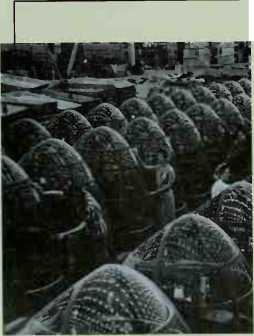Africa At the end of 1942, the Allies
Were not yet ready to try an invasion of Nazi-held France. But the Soviet Union could not fight the Germans alone; they needed another front to draw some of Hitler's heat. The Allies decided to strike at Hitler from the south. They would first battle the Germans for North Africa, then invade Italy via the Mediterranean.
Fight for the Desert. Italian troops had moved into Egypt in September 1940, going for the Suez Canal. The British counterattacked, eventually forcing the surrender of Mussolini’s troops in February 1941.
Hitler, however, was not willing to let the British defeat his A. xis allies. He sent in the crack armored Afrika Korps under General Erwin Rommel. The Germans went on the offensive in Februaiy 1941, pushing through Libya. Even though Rommel was outnumbered, the German general was able to shove the British right back into Egypt. On June 21, 1942, the British garrison of Tobmk fell with 33,000 men. The British were humiliated.
Battle of El ALAMEIN. in late October, the Allied
Forces were under new command. The British were determined to take back their ground in Egypt. Allied forces led by British General Bernard Montgomery got ready for an offensive.
Montgomery, who believed in having overwhelming superiority in a battle, had it in spades. The Allied army boasted 195,000 men and a thousand tanks. Its crushing offensive finally broke the Axis back at El Alamein. German and Italian casualties were more than 90,000. El Alamein was the first decisive victory on land for the British.
U. S. Troops Ashore, in the second week of November 1942, more than 100,000 Allied troops, mainly Americans, made their way onto the Mediterranean shores of Morocco and Algeria. They hoped to cut off Rommel’s line of retreat.
The landings were politically tricky for the Allies. Under the terms of the French-German armistice, these North African French colonies were now in the hands of the Vichy French government. This puppet government was pledged to defend Morocco and Algeria against any attacks. Still there was some hope that the French would not oppose the landings. U. S. soldiers, in fact, faced only slight resistance coming ashore.
During the landings, however. Hitler ordered the seizure of the still powerful French fleet. A total of about 80 warships were at anchor in Toulon, France, when the order came. Before the Germans could get to them, however, the French crews scuttled nearly every ship.

One of the things that really depressed German General Rommel in North Africa was how many spare parts the Americans had. Those spare parts, munitions, and supplies were coming from the biggest factory on the face of the earth—the United States of America. While U. S. soldiers were battling Axis forces overseas, Americans at home were working in the national arsenal. Unemployment vanished; factories stayed open for two or three shifts. Women who had never worked away from home before became the heart and hands of the U. S. labor force.
The staggering output was relief to America’s Allies, a terror to its enemies.
During the war, the United States produced.
Among other things:
300.000 aircraft
88.000 landing craft 215 submarines 147 aircraft carriers 952 warships 86,333 tanks
531,000,000 tons ot bombs
12.573.000 rifles/carbines
U. S. production not only supplied American forces, but aided its Allies—Britain and the U. S.S. R. The Axis powers suffered many hardships because of the U. S. entry into the war. But no pill proved as bitter to swallow as the United States’ endless supplies.
Rosie the Riveter flexes her muscle. U. S. women took over much of the job of producing arms and supplies for the troops. The war could not have been ivoji without their astonishing effort.
While the British continued to move west, the American troops, commanded by General Dwight D. Eisenhower, would move east. If the plan worked, the Allies could trap the Axis armies in one of the greatest pincer moves in military history.
Most U. S. soldiers landing in North Africa had never seen combat. They weren’t up to fighting battle-hardened German troops. Nor was their equipment. Americans were unpleasantly surprised at Chouigui when their M3 cannon shells Ijounced right off German tanks. Heavy air attacks from the German Luftwaffe made it impossible to keep advancing.
By January, Rommel was in Tunisia, having been dogged across North Africa by Montgomery. For now, Rommel believed the Americans could be handled. He promised to give them "an inferiority comple. x of no mean order."
Kasserine Pass. Rommel soon got his chance to humiliate American soldiers. In February 1943, U. S. troops were chased across the middle of Tunisia, having lost two battalions at Sidi Bou Zid.
The Americans holed up in a range of mountains known as the West Dorsal. Along the ridge was the
“Gentlemen, you have fought like lions and been led by donkeys. ”
—General Rommel to captured British officers after Tobruk
Kasserine Pass, an important gateway to Algeria. It was also the gate to the town of Tebessa, an important supply and communication base.
During the day on Febioiary 19, the Americans managed to repel a tank attack along the Kasserine from the Afrika Panzer Korps. But later that night, German infantry worked their way up the hills and caught the Americans by surprise. By the following day, A. xis forces had broken through the American lines.
Retreat from Victory. The Americans, confused and
Shocked at first, learned their lesson quickly. They would not easily be overrun again. The U. S. Army also had munitions and materiel to spare. German supplies were

Down to practically nothing. Rommel himself was sick with jaundice and heat. He decided to call it quits.
The battle at Kasserine Pass would be Field Marshal Rommel’s last victory in Africa. From that point on, he had lost faith that the campaign in North Africa was winnable. The Afi'ika Korps would, in fact, surrender in May. By that time, Rommel was long gone: Hitler had called him back to Gemrany to help defend the French coast.
Casablanca Conference. While Allied and Axis soldiers were battling it out in Tunisia, Roosevelt and Churchill were meeting in Morocco. The Allied leaders were trying to decide where to strike next. Roosevelt wanted to make a decisive blow against Hitler in France. Churchill, who had watched the humiliating evacuation of Dunkirk, wasn’t so sure. He thought it might be smarter to “nibble” at Hitler. A decisive blow could be struck later when the time was right.
Eventually the Allies compromised. After victoiw was achieved in North Africa, Allied forces would attack and occupy the island of Sicily. The Gennans were weakest in the Mediteiranean. If the Allies attacked here, they could cany the war up into Greece and Turkey. The Germans would then be caught between a rock and a hard place—between them and the Russians.




 World History
World History









